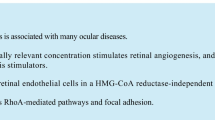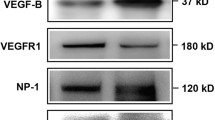Abstract
Objective
To study the effect of peroxisome proliferator-activated receptor-gamma (PPARγ) agonists, pioglitazone and rosiglitazone, on vascular endothelial growth factor (VEGF)- and basic fibroblast growth factor (bFGF)-induced angiogenesis and on endothelial cell migration.
Methods
Chick chorioallantoic membrane (CAM) model was used to evaluate the efficacy of pioglitazone and rosiglitazone on VEGF- and bFGF-induced angiogenesis. In addition, the effect of pioglitazone and rosiglitazone on endothelial cell migration was evaluated using 8 mm pore filter to a feeder layer containing vitronectin as chemoattractant.
Results
Pioglitazone and rosiglitazone inhibited the pro-angiogenic effects of bFGF and VEGF in the CAM model significantly (P < 0.001) to the same extent. Endothelial cell migration was also inhibited by both pioglitazone and rosiglitazone (P < 0.001).
Conclusions
These results suggest that PPARγ ligands, pioglitazone and rosiglitazone, in addition to their important regulatory role in adipogenesis and inflammation, possess anti-angiogenic properties. Thus, PPARγ ligands may be useful in the treatment of diabetic retinopathy, macular degeneration, and other ocular disorders and may lower the risk to develop cancer in diabetic patients.




Similar content being viewed by others
References
Laukkanen JA, Laaksonen DE, Niskanen L, Pukkala E, Hakkarainen A, Salonen JT (2004) Metabolic syndrome and the risk of prostate cancer in Finnish men: a population-based study. Cancer Epidemiol Biomarkers Prev 13:1646–1650
Coughlin SS, Calle EE, Teras LR, Petrelli J, Thun MJ (2004) Diabetes mellitus as a predictor of cancer mortality in a large cohort of US adults. Am J Epidemiol 159:1160–1167. doi:10.1093/aje/kwh161
Khaw KT, Wareham N, Bingham S, Luben R, Welch A, Day N (2004) Preliminary communication: glycated hemoglobin, diabetes, and incident colorectal cancer in men and women: a prospective analysis from the European prospective investigation into cancer-Norfolk study. Cancer Epidemiol Biomarkers Prev 13:915–919
Inoue M, Iwasaki M, Otani T, Sasazuki S, Noda M, Tsugane S (2006) Diabetes mellitus and the risk of cancer: results from a large-scale population-based cohort study in Japan. Arch Intern Med 166:1871–1877. doi:10.1001/archinte.166.17.1871
Veldt BJ, Chen W, Heathcote EJ, Wedemeyer H, Reichen J, Hofmann WP et al (2008) Increased risk of hepatocellular carcinoma among patients with hepatitis C cirrhosis and diabetes mellitus. Hepatology 47:1856–1862. doi:10.1002/hep.22251
Saez E, Tontonoz P, Nelson MC, Alvarez JG, Ming UT, Baird SM et al (1998) Activators of the nuclear receptor PPARgamma enhance colon polyp formation. Nat Med 4:1058–1061. doi:10.1038/2042
Mueller E, Sarraf P, Tontonoz P, Evans RM, Martin KJ, Zhang M et al (1998) Terminal differentiation of human breast cancer through PPAR gamma. Mol Cell 1:465–470. doi:10.1016/S1097-2765(00)80047-7
Tontonoz P, Nagy L, Alvarez JG, Thomazy VA, Evans RM (1998) PPARgamma promotes monocyte/macrophage differentiation and uptake of oxidized LDL. Cell 93:241–252. doi:10.1016/S0092-8674(00)81575-5
Nagy L, Tontonoz P, Alvarez JG, Chen H, Evans RM (1998) Oxidized LDL regulates macrophage gene expression through ligand activation of PPARgamma. Cell 93:229–240. doi:10.1016/S0092-8674(00)81574-3
Escher P, Wahli W (2000) Peroxisome proliferator-activated receptors: insight into multiple cellular functions. Mutat Res 448:121–138. doi:10.1016/S0027-5107(99)00231-6
Yajima K, Hirose H, Fujita H, Seto Y, Fujita H, Ukeda K et al (2003) Combination therapy with PPARgamma and PPARalpha agonists increases glucose-stimulated insulin secretion in db/db mice. Am J Physiol Endocrinol Metab 284:E966–E971
Keshamouni VG, Arenberg DA, Reddy RC, Newstead MJ, Anthwal S, Standiford TJ (2005) PPAR-gamma activation inhibits angiogenesis by blocking ELR + CXC chemokine production in non-small cell lung cancer. Neoplasia 7:294–301. doi:10.1593/neo.04601
Kolak M, Yki-Jarvinen H, Kannisto K, Tiikkainen M, Hamsten A, Eriksson P et al (2007) Effects of chronic rosiglitazone therapy on gene expression in human adipose tissue in vivo in patients with type 2 diabetes. J Clin Endocrinol Metab 92:720–724. doi:10.1210/jc.2006-1465
Jha RJ (1999) Thiazolidinediones–the new insulin enhancers. Clin Exp Hypertens 21:157–166
Lebovitz HE, Banerji MA (2001) Insulin resistance and its treatment by thiazolidinediones. Recent Prog Horm Res 56:265–294. doi:10.1210/rp.56.1.265
(2000) Actos (pioglitazone HCL) provides a safe, effective alternative for patients formerly taking Rezulin. Diabetes Technol Ther 2:290–291
Carmeliet P (2005) Angiogenesis in life, disease and medicine. Nature 438:932–936. doi:10.1038/nature04478
Risau W (1997) Mechanisms of angiogenesis. Nature 386:671–674. doi:10.1038/386671a0
Jain RK (2005) Normalization of tumor vasculature: an emerging concept in antiangiogenic therapy. Science 307:58–62. doi:10.1126/science.1104819
De Luca A, Carotenuto A, Rachiglio A, Gallo M, Maiello MR, Aldinucci D et al (2008) The role of the EGFR signaling in tumor microenvironment. J Cell Physiol 214:559–567. doi:10.1002/jcp.21260
Mousa SA, O’Connor LJ, Bergh JJ, Davis FB, Scanlan TS, Davis PJ (2005) The proangiogenic action of thyroid hormone analogue GC-1 is initiated at an integrin. J Cardiovasc Pharmacol 46:356–360. doi:10.1097/01.fjc.0000175438.94906.a0
Colman RW, Pixley RA, Sainz IM, Song JS, Isordia-Salas I, Muhamed SN et al (2003) Inhibition of angiogenesis by antibody blocking the action of proangiogenic high-molecular-weight kininogen. J Thromb Haemost 1:164–170. doi:10.1046/j.1538-7836.2003.00025.x
Bozarth J, Penno M (1997) SAM: an improved method for the quantitation of cellular migration–role of avb3 integrin in endothelial and smooth muscle cell migration. Methods Cell Sci 19:179–187. doi:10.1023/A:1009789416463
Lemberger T, Desvergne B, Wahli W (1996) Peroxisome proliferator-activated receptors: a nuclear receptor signaling pathway in lipid physiology. Annu Rev Cell Dev Biol 12:335–363. doi:10.1146/annurev.cellbio.12.1.335
Fruchart JC, Duriez P, Staels B (1999) Peroxisome proliferator-activated receptor-alpha activators regulate genes governing lipoprotein metabolism, vascular inflammation and atherosclerosis. Curr Opin Lipidol 10:245–257. doi:10.1097/00041433-199906000-00007
Suchanek KM, May FJ, Robinson JA, Lee WJ, Holman NA, Monteith GR et al (2002) Peroxisome proliferator-activated receptor alpha in the human breast cancer cell lines MCF-7 and MDA-MB-231. Mol Carcinog 34:165–171. doi:10.1002/mc.10061
Engel J, Rabba J, Schild D (1996) A transient, RCK4-like K+ current in cultured Xenopus olfactory bulb neurons. Pflugers Arch 432:845–852. doi:10.1007/s004240050207
Xin X, Yang S, Kowalski J, Gerritsen ME (1999) Peroxisome proliferator-activated receptor gamma ligands are potent inhibitors of angiogenesis in vitro and in vivo. J Biol Chem 274:9116–9121. doi:10.1074/jbc.274.13.9116
Marx N, Bourcier T, Sukhova GK, Libby P, Plutzky J (1999) PPARgamma activation in human endothelial cells increases plasminogen activator inhibitor type-1 expression: PPARgamma as a potential mediator in vascular disease. Arterioscler Thromb Vasc Biol 19:546–551
Satoh H, Tsukamoto K, Hashimoto Y, Hashimoto N, Togo M, Hara M et al (1999) Thiazolidinediones suppress endothelin-1 secretion from bovine vascular endothelial cells: a new possible role of PPARgamma on vascular endothelial function. Biochem Biophys Res Commun 254:757–763. doi:10.1006/bbrc.1998.0126
Panigrahy D, Huang S, Kieran MW, Kaipainen A (2005) PPARgamma as a therapeutic target for tumor angiogenesis and metastasis. Cancer Biol Ther 4:687–693
Murata T, He S, Hangai M, Ishibashi T, Xi XP, Kim S et al (2000) Peroxisome proliferator-activated receptor-gamma ligands inhibit choroidal neovascularization. Invest Ophthalmol Vis Sci 41:2309–2317
Goetze S, Eilers F, Bungenstock A, Kintscher U, Stawowy P, Blaschke F et al (2002) PPAR activators inhibit endothelial cell migration by targeting Akt. Biochem Biophys Res Commun 293:1431–1437. doi:10.1016/S0006-291X(02)00385-6
Goetze S, Bungenstock A, Czupalla C, Eilers F, Stawowy P, Kintscher U et al (2002) Leptin induces endothelial cell migration through Akt, which is inhibited by PPARgamma-ligands. Hypertension 40:748–754. doi:10.1161/01.HYP.0000035522.63647.D3
Huang H, Campbell SC, Bedford DF, Nelius T, Veliceasa D, Shroff EH et al (2004) Peroxisome proliferator-activated receptor gamma ligands improve the antitumor efficacy of thrombospondin peptide ABT510. Mol Cancer Res 2:541–550
Panigrahy D, Singer S, Shen LQ, Butterfield CE, Freedman DA, Chen EJ et al (2002) PPARgamma ligands inhibit primary tumor growth and metastasis by inhibiting angiogenesis. J Clin Invest 110:923–932
Sierra-Honigmann MR, Nath AK, Murakami C, Garcia-Cardena G, Papapetropoulos A, Sessa WC et al (1998) Biological action of leptin as an angiogenic factor. Science 281:1683–1686. doi:10.1126/science.281.5383.1683
Giannini S, Serio M, Galli A (2004) Pleiotropic effects of thiazolidinediones: taking a look beyond antidiabetic activity. J Endocrinol Invest 27:982–991
Hicklin DJ, Ellis LM (2005) Role of the vascular endothelial growth factor pathway in tumor growth and angiogenesis. J Clin Oncol 23:1011–1027. doi:10.1200/JCO.2005.06.081
Fahmy RG, Dass CR, Sun LQ, Chesterman CN, Khachigian LM (2003) Transcription factor Egr-1 supports FGF-dependent angiogenesis during neovascularization and tumor growth. Nat Med 9:1026–1032. doi:10.1038/nm905
Kim KJ, Li B, Winer J, Armanini M, Gillett N, Phillips HS et al (1993) Inhibition of vascular endothelial growth factor-induced angiogenesis suppresses tumour growth in vivo. Nature 362:841–844. doi:10.1038/362841a0
Yan W, Bentley B, Shao R (2008) Distinct angiogenic mediators are required for basic fibroblast growth factor- and vascular endothelial growth factor-induced angiogenesis: the role of cytoplasmic tyrosine kinase c-Abl in tumor angiogenesis. Mol Biol Cell 19:2278–2288. doi:10.1091/mbc.E07-10-1068
Michalik L, Desvergne B, Wahli W (2004) Peroxisome-proliferator-activated receptors and cancers: complex stories. Nat Rev Cancer 4:61–70. doi:10.1038/nrc1254
Kaipainen A, Kieran MW, Huang S, Butterfield C, Bielenberg D, Mostoslavsky G (2007) PPARalpha deficiency in inflammatory cells suppresses tumor growth. PLoS ONE 2:e260. doi:10.1371/journal.pone.0000260
Panigrahy D, Kaipainen A, Huang S, Butterfield CE, Barnes CM, Fannon M et al (2008) PPARalpha agonist fenofibrate suppresses tumor growth through direct and indirect angiogenesis inhibition. Proc Natl Acad Sci USA 105:985–990. doi:10.1073/pnas.0711281105
Strickler HD, Wylie-Rosett J, Rohan T, Hoover DR, Smoller S, Burk RD et al (2001) The relation of type 2 diabetes and cancer. Diabetes Technol Ther 3:263–274. doi:10.1089/152091501300209633
Govindarajan R, Ratnasinghe L, Simmons DL, Siegel ER, Midathada MV, Kim L et al (2007) Thiazolidinediones and the risk of lung, prostate, and colon cancer in patients with diabetes. J Clin Oncol 25:1476–1481. doi:10.1200/JCO.2006.07.2777
Shen LQ, Child A, Weber GM, Folkman J, Aiello LP (2008) Rosiglitazone and delayed onset of proliferative diabetic retinopathy. Arch Ophthalmol 126:793–799. doi:10.1001/archopht.126.6.793
Author information
Authors and Affiliations
Corresponding author
Rights and permissions
About this article
Cite this article
Aljada, A., O’Connor, L., Fu, YY. et al. PPARγ ligands, rosiglitazone and pioglitazone, inhibit bFGF- and VEGF-mediated angiogenesis. Angiogenesis 11, 361–367 (2008). https://doi.org/10.1007/s10456-008-9118-0
Received:
Accepted:
Published:
Issue Date:
DOI: https://doi.org/10.1007/s10456-008-9118-0




